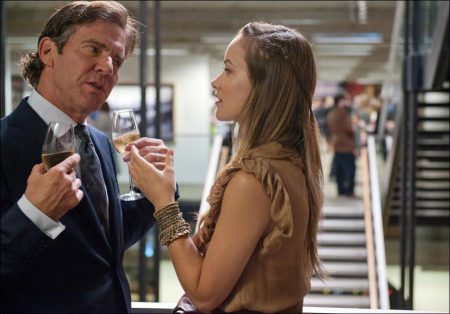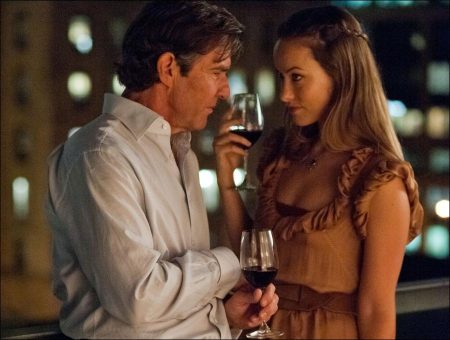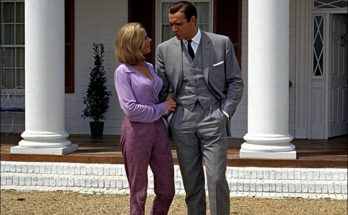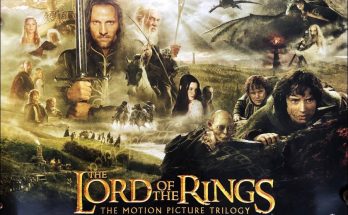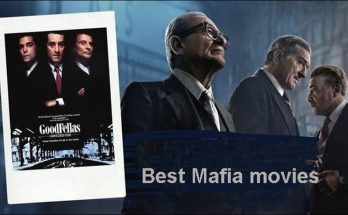The Words began production in Montreal on June 5, 2011. Although the duo were in tandem on all decisions involving the direction of the film, Klugman worked primarily with the cast while Sternthal focused on the other filmmakers – their segregated duties banishing concerns over their inabilities of leadership on the set.
That was crucial to talent the level of Irons. “Working with directors who are also the screenwriters can be tricky,” Irons says. “But what Lee and Brian are interested in – and what they’re right to be interested in – is what actually happens between two characters: what happens in a situation, not the exact form or selection of what they’ve written. And so they’re very free about that. They know what they want to get out of a scene and their words are a kind of map of how to get there, but they’re very open to suggestions, to alterations, to whatever. That’s rare and delightful.”
The duo gave a wide berth of input to the other filmmakers as well. “There’s a time to do your own work and there’s a time to collaborate and I think when you make the film, you want to collaborate. Especially with people who are so talented,” says Sternthal. “I loved working with (Cinematographer) Antonio Calvache. He shot a beautiful movie here, so many beautiful images. He is a genius. I learned so much from him and feel honored to have worked with him on this film. I hope that people love the work that he did. It was truly an amazing experience.”
Calvache says he was drawn to the project because of the first 40 magical pages of the script, the scene between Rory and the Old Man on the park bench. “Almost it didn’t matter what else happened afterwards, I was already in. Then I met the directors and I liked them a lot.”
For the film’s Director of Photography, “one of the most appealing elements of THE WORDS is the multi- layered structure. Visually, it opened the door to find different visual schemes for each part of the story. Planning the different photographic approach to the three different layers of the story was the most fun part of the job.”
“We planned on making Clay’s story very clean, straight, realistic, using very contemporary modern city settings in Montreal,” Calvache explains. “Very achromatic, but not in a stylized manner, just in the choice of locations, art direction and wardrobe. I had originally imagined it much more static than it eventually turned out to be. I wanted to reserve the movement for the fictional part of the movie. But Dennis and Olivia often engaged in a choreography that requested and invited the camera to move, and it worked nicely in the end.”
Calvache says he “loved the way Rory’s story was introduced, with the rain at night on a street in Manhattan. The idea of making that opening a techno-crane shot in the rain was one of the first and stronger images that came out of my early meetings with the directors and actually turned out to be amazingly close in the film to the vision in my head. It was quite a struggle for our low budget production to allow for such an ambitious shot and it was not absent of troubles at the time of filming, but I think very worthwhile. We wanted to add a lot of visual drama to that moment of the movie, when we are introduced for the first time to Rory and the Old Man… very strong visuals, with rain, shadows, and other film noir visual elements. I couldn’t stop myself from thinking of the lonely man in Edward Hopper’s painting “Nighthawks.” When we go back to the start of Rory’s writing career, as he and Dora move to New York, we introduced a lot more color in the palette of the movie. Blue became kind of a talisman color. I wanted to be able to capture Zoe’s beautiful golden skin tones, and Bradley’s striking blue eyes.”
And then there was Paris. “THE WORDS’ visuals became increasingly evocative in the flashbacks to the Old Man’s story in post-WWII Paris,” he explains. Playing with every optical and film technique he could imagine to shape the look of those flashbacks, “I wanted to transport the audience and make them very emotionally attached to this part of the movie — an ode to love – romantic love, love of books, love of writing. Of course the reality of shooting this part of the film was more about the challenges involved with making present time Montreal look like 1940’s Paris.”
Working closely with the directors, Calvache says the script actually dictated much of what appeared on the screen. “A lot of visual ideas came from meetings with the directors and during the shoot, our collaboration so close I wouldn’t be able to remember who came up with which idea. But, I must give credit to the producers for allowing me to use all the different techniques to differentiate the different layers of the story, including experimenting with many camera and processing tricks for the period look. They were in synch with the directors and they also deserve credit in the creative choices that involved giving the special look to this film. With the slim budget and very tight schedule, turning present time Montreal into period Paris, kudos to our producers and our Montreal crew for allowing the miracle of this film to happen.”
For the producers, Montreal was the solution to time and budget constraints. “When you look at Montreal, you recognize that it is a very good city to double for New York and Paris. Tatiana Kelly had gone to school here and knew the city very well,” says Rister. “The end result is that we got our locations, and we got a topnotch crew that we couldn’t be happier with. The city has been very friendly to us.”
Young concurs: “Numerous members of the crew work on big projects. They came to this one because of a love for the script and for the filmmakers.”
Producer Michael Benaroya attributes the dynamic to a sense of “ownership. Everyone, from the Director of Photography to the assistant directors to the set and costume designers – everyone worked extremely hard,” he observed.
Respected Art Director Michèle Laliberte who marked her debut as Production Designer on THE WORDS, chose several parks and green areas to create post-WWII Paris, while contemporary locations in downtown Montreal were used for Clay’s and Rory’s apartments as well as the Old Man’s hotel. What became tricky, were the period scenes at the train station.
“We were either going to CGI the train station or the train since we don’t have a Paris train station in Montreal,” Laliberte says. After scouting numerous locations, she found the Musee Ferroviaire in Saint-Constant, a museum just outside of Montreal. With a little CGI help, “I think it was kind of convincing as a Paris train station. The museum of course doesn’t move, so we worked around it to give the feeling of movement of the train. The props were more about removing stuff that looked wrong, disguising anything that was not period with minimalist interventions.”
In creating the wardrobe for Paris 1945, Costume Designer Simonetta Mariano says layering was a factor. “We cheated by dressing them up with lots of layers and as the show was going on we would peal them off, or put the coats on. That’s how we created different looks with the extras.”
She remembers how important it was to Irons to cover all details in creating the Old Man’s look. “When we started prepping, he was the first actor I spoke to and he was going to come at the last minute so I wanted to be prepared. I bought a lot of coats at a second-hand shop, put them on a dummy, took pictures, created a gallery and emailed them to him. A 45-minute telephone conversation” ensued and “he would say ‘Oh, I like the hat, or perhaps the shoes,’ and we created the Old Man. The most touching thing with him is that he refused to wear anything new.”
Cast aside, it was the care, input and attention to detail by everyone involved that breathed life into Klugman and Sternthal’s WORDS.
“When you’re doing 12-hour shifts for 25 days, it’s insane and we couldn’t have done what we did without a crew like this,” says Sternthal. “You want to hear what they have to say. I mean, sometimes it goes in directions that you didn’t anticipate and one of the joys is seeing what other people bring, all their experiences, what they’re creating out of it and that includes everybody… the craft service person, the person driving the van – you’re driving to work and they’re like ‘Hey you know that scene where…’and it is an amazing idea. That collaboration is the joy of it.”
Visits: 44
